Self-loading pistol Mannlicher M1894 (Austria-Hungary)
One of the pioneers of the promising direction was the Austro-Hungarian gunsmith Ferdinand Manliher. Since the early eighties of the XIX century, he developed several samples of small arms, which were of great interest to potential customers. The next creation of the engineer was supposed to be a new self-loading pistol. The project of the new weapon was completed in 1894 year, which led to the appearance of the corresponding designation. It should also be noted that the Mannlicher M1894 self-loading pistol, having appeared by the mid-nineties of the 19th century, became one of the first representatives of its class.
At that time, gunsmiths of several countries were working on the development of automation for advanced pistols, but have not yet found the optimal schemes for such mechanisms. As a result, each new project was actually experimental and was intended to work out new ideas. No exception and the project F. Manlichera. His M1894 pistol was created, among other things, to check the original technical proposal. The main feature of the project was to be the use of a roll-out barrel - not the most popular solution in the past as well as now.
The essence of F. Manlicher's proposal was to use a fixed frame and a pistol bolt. Move and recharge, in turn, should have a barrel. The Mannlicher M1894 pistol can be considered the first model of a weapon with such automation, which has reached mass production. Later on, some other similar models were developed, which differed from the M1894 pistol in certain design features. It is noteworthy that all of them were not widely spread and in popularity were much inferior to weapons based on other principles.
The main part of the new pistol was a special shape frame, which united the bolt cover with the pistol grip. It was a unit of complex shape, which allowed to put inside all the necessary details. Thus, the upper part contained a movable barrel, the details of the firing mechanism were located in the central part, and a place for ammunition was provided in the handle. The central part of the frame, which served as the casing of USM, did not have a left wall. Instead, it was proposed to install a protective cover of the appropriate form on the weapon. The pistol grip was covered on both sides with wooden overlays. There was a large "revolving" protective bracket.
In the front top of the frame it was proposed to wind the barrel housing. With the help of a thread on the frame a detail of a complex shape was fixed, made in the form of three coaxial cylinders of different sizes with a longitudinal bar on the upper surface. Inside the casing there should have been a moving barrel and a return spring. The use of an additional casing made it possible to a certain extent to simplify the manufacture of weapons, dividing the main large part into two parts.
Inside its own casing, formed by the frame and the front part, it was proposed to place a rifled barrel, which had the possibility of reciprocating movement. In the initial configuration of the pistol, the barrel had a caliber of 6,5 mm and a length of 165 mm. The barrel had a relatively thin front half, and the rear should have a larger diameter. On the bottom surface of the thickened breech provided two figured notches for contact with the details of the firing mechanism. On top of the chamber there was a small handle to move the barrel when reloading weapons.
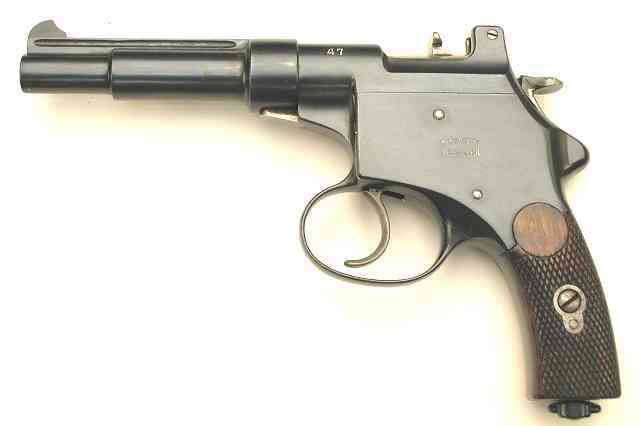
Left view. You can see the border of the frame cover. Hungariae.com Photos
When assembling a pistol, it was necessary to place the barrel into the frame, then put a return spring on it and screw the front cover on the frame. With the help of a spring resting on the wall of the casing, the barrel was securely fixed in the rearmost position. At the same time it was possible to move it with the help of a handle designed to prepare the weapon for firing. For the free movement of the handle, including when installing the barrel, a long slot was provided in the upper surface of the frame. In the rear part it expanded and served as a window for ejection of the cartridge case, and with the help of a pair of projections it could hold the clip with cartridges.
Locking the barrel was not provided. Before the shot, the barrel had to be positioned in the rearmost position and held by the return spring, while its breech pressed against the plate, which served as a shutter. The latter was part of the frame and had a through hole for the passage of the drummer, placed on the trigger.
Under the barrel inside the frame there was a trigger mechanism of relatively simple design. F. Manlicher managed to get by with just a few details: without taking into account the axes, the trigger was equipped with a trigger with a drummer, a sear, a trigger and a combat spring. The whisper was intended to hold the barrel in the extreme forward position, the trigger and the V-shaped spring (it was connected to the trigger and the trigger) were responsible for firing the shot, and the trigger had to activate the mechanisms. It should be noted, the reduction in the number of parts led to the need to develop units of relatively complex shape. All the details of the new trigger, first of all the trigger, had curved contours and a mass of protrusions or slots for proper contact with each other.
The gun Mannlicher M1894 could work like a revolving system of the main classes (taking into account the use of additional parts associated with the barrel). At the request of the shooter, the shot could be made with or without manual cocking of the trigger. In the latter case, the trigger is cocked under the action of the pressed trigger. Borrowing revolving ideas made it possible to abandon special parts of the fuse. For the safe handling of weapons, it was suggested not to cock the trigger yourself, not to move the barrel, not to send the cartridge and not to pull the trigger without need. It was assumed that a reasonable approach to exploitation would eliminate accidents.
The new pistol received a store of just five rounds. Moreover, due to the lack of developments in this area, the store was made integrated into the frame. Its removal was not provided, and the loading was proposed to carry out with the help of clips. The base of the store was an inclined tube of rectangular section, inside which there was a spring-loaded feeder. When the cartridges were fully loaded, the feeder in its lower position was at the level of the upper part of the trigger. When making shots, the feeder had to pick up the cartridges on the dismounting line. An interesting feature of the M1894 project was the relative position of the store and the details of the firing mechanism. Details USM were pressed to the right wall of the frame, and to the left of them, on the longitudinal axis of the weapon, there was a shop.
The pistol received the most simple sights. There was an unregulated front sight on the front of the barrel casing, on its longitudinal bar, and a slot was made in the enlarged plate of the bolt, which made it entirely. Such a sight allowed to fire at distances of no more than several tens of meters, i.e. within the capabilities of a relatively weak cartridge.
The general appearance of the Mannlicher M1894 pistol and the layout of the main units resembled revolvers of that time. First of all, such a weapon is remembered due to the curved handle, protruding down the trigger guard and, of course, the open trigger with the possibility of manual cocking. Also on the handle was provided for the traditional loop for that time for a safety strap.
To start shooting it was required to load the weapon and prepare it for the shot. To do this, the barrel with its own handle shifted to the extreme front position, in which the muzzle part protruded from the casing. When this occurred, the return spring was compressed and the trunk was fixed with the help of its lower recess and sear. To hold the barrel in the forward position, it was necessary to keep the trigger pressed. Then, in the frame window, a clip with five 6,5x23 mm R Manreher cartridges or another type should be placed, for which there was a guide in the rear part of the window. After sending the cartridges to the store and retrieving the empty clip, the trigger could be released - the weapon was ready to fire.
At his own wish, the shooter could pre-trigger and lock it in that position, or do nothing and use the opportunity to work on the so-called double action scheme. Regardless of the actions of the shooter, the general principles of operation of the mechanisms of the pistol were similar.
When the trigger was released after loading the magazine, the barrel returned to the rear position under the action of a spring, capturing the upper cartridge from the magazine with the chamber chamber. In the rearmost position of the barrel, the cartridge fully entered the chamber and pressed against the gate plate. The weapon could make a shot. In the case of pre-cocking, the trigger, when pressed for a shot, released the trigger and, under the action of a V-shaped spring, turned forward, inserted the drummer into the bolt hole and hit them on the cartridge primer. When using the double action trigger, pulling the trigger led to cocking the hammer with its subsequent descent. This procedure was provided curly contours of parts in contact with each other.
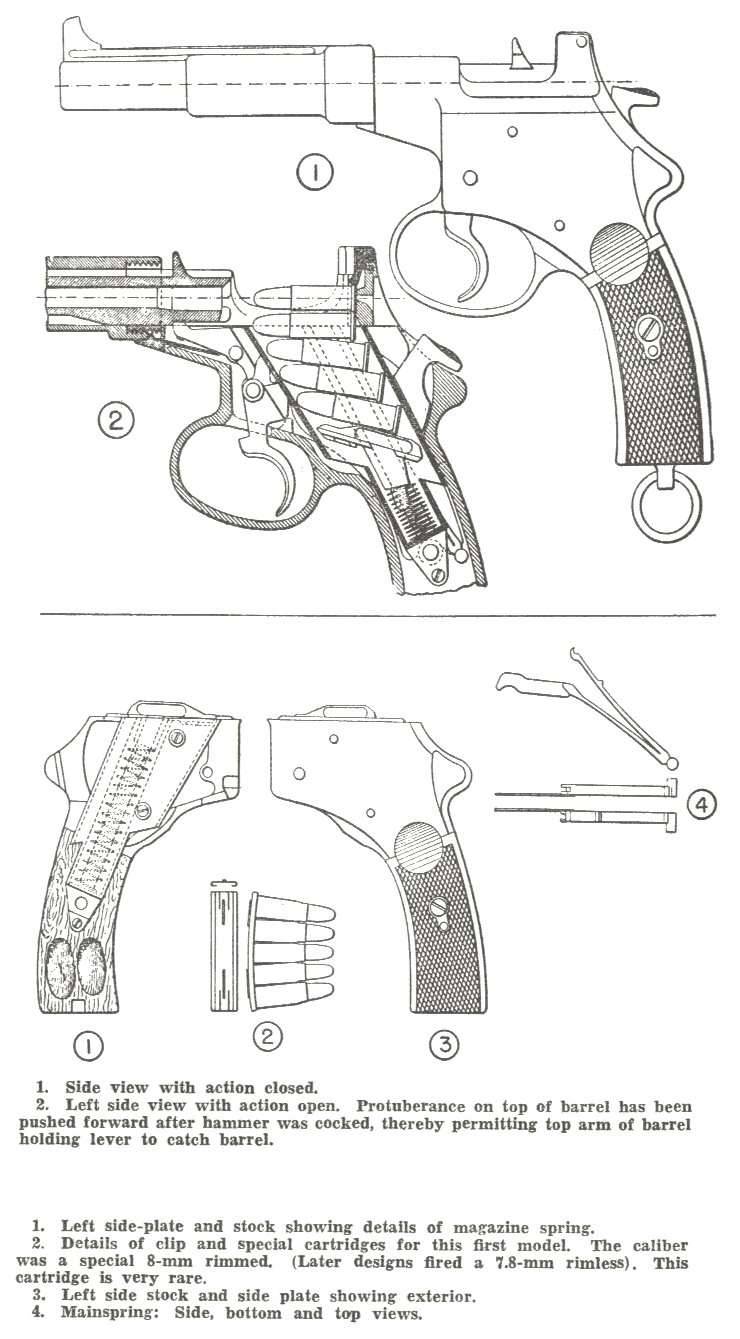
Drawing of the filing system cartridges. Figure Wikimedia Commons
After hitting the primer, the propellant ignited and shot. Moving along the barrel, the bullet had to enter the rifling and thereby transfer some of its energy to them. Since the pistol bolt was made stationary, the barrel had to move under the action of powder gases. During the shot, he pushed forward, squeezed the return spring and under its action came back. During the movement of the barrel elements in the rear of the frame produced the extraction and ejection of the liner. USM is not automatically cocked. The spring of the store led out to the line of filing a new cartridge, after which it fell into the backward moving barrel. For the next shot, you had to manually pull the trigger or just pull the trigger.
The first version of the Mannlicher M1894 pistol was developed to use the 6,5x23 mm R Mannisher cartridge. Such weapons had a total length (with a “retracted” barrel) of the order of 215 mm and a weight without cartridges of no more than 850 g. The magazine contained five cartridges. The dimensions and weight of the new weapons were at the level of the existing models, which, in theory, made it possible to compete with them, at least in terms of ergonomics.
There is information about the development of the project, resulting in the creation of a modification for a new cartridge. The second version of the weapon was to use 7,5x23 mm R Mannisher ammunition. A larger cartridge led to some increase in the size and weight of the weapon: 230 mm length and 1 kg weight without ammunition. However, in terms of these parameters, the M1894 pistol in the 7,5-mm version was not very different from the basic design. Some sources claim that the first was a 7,5-mm pistol, but this version does not receive other confirmations.
According to reports, in 1894, Ferdinand Mannicher agreed with the weapons company Fabrique D'Armes de Neuhaussen (now Swiss Arms) to produce the first batch of new pistols. As part of this order, no more than 50-60 weapons were manufactured for an 6,55 mm caliber cartridge. These products were intended for testing in the interests of the Swiss army. The gunsmith planned to offer his development to the armed forces of several countries. It was for these reasons that a modification was soon created for a different cartridge.
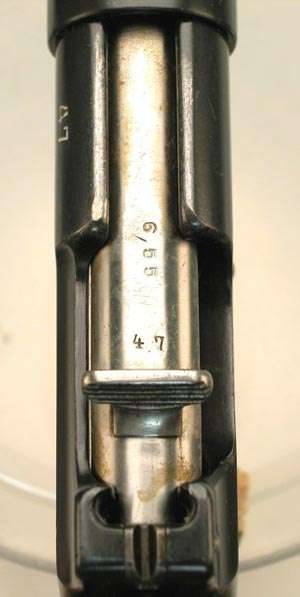
Top view of the trunk and frame. Photo Weaponland.ru
The M1894 pistol was offered to the armies of Austria-Hungary, Switzerland, the USA and other countries. According to some information, even the Russian command was offered weapons. In some countries, the new F. Mannicher pistols passed tests, but did not receive the approval of the military. The reason for this was the specific characteristics of the weapon, as well as, as it turned out later, its low reliability.
The most famous are the test results of the M1894 pistol in the United States. The American experts of the Springfield Arsenal in June 1900 conducted the necessary checks and were dissatisfied with the results. The gun showed too low performance, and also completed a breakdown test, which could not be fixed. Because of this, the tests were discontinued, and the gun itself did not receive recommendations for adoption and could not replace the existing weapons in the troops.
During the tests at the Springfield arsenal test site, the M1894 pistol proved to be not the best. Low reliability was demonstrated by almost all major weapon assemblies. Thus, the ammunition supply system often led to a misalignment of cartridges with the cessation of firing. It turned out to be unreliable and the trigger mechanism, which often gave misfires. Thus, even with the correct filing of the cartridge, the shot was not guaranteed. During the time of relatively short trials, American experts have managed to fix an unacceptably large number of problems.
However, the biggest unpleasant surprise awaited the testers at the end of the third hundred test shots. When a 281 shot was fired, the design of the gun did not withstand the loads. There was a rupture of the trunk. The necessary parts were missing, because of what they had to stop testing, and also to make a gun a disappointing sentence.
According to the Springfield arsenal, the Mannlicher M1894 pistol had insufficient performance and reliability. This weapon was considered as an alternative to revolvers in service with weapons and therefore was compared with them. The advantages of the proposed gun attributed to the simplicity of design and small size. On this positive features ended. The testers noted that the various features of the design of these weapons do not give any advantage over the revolvers, and sometimes even lead to lagging behind them.
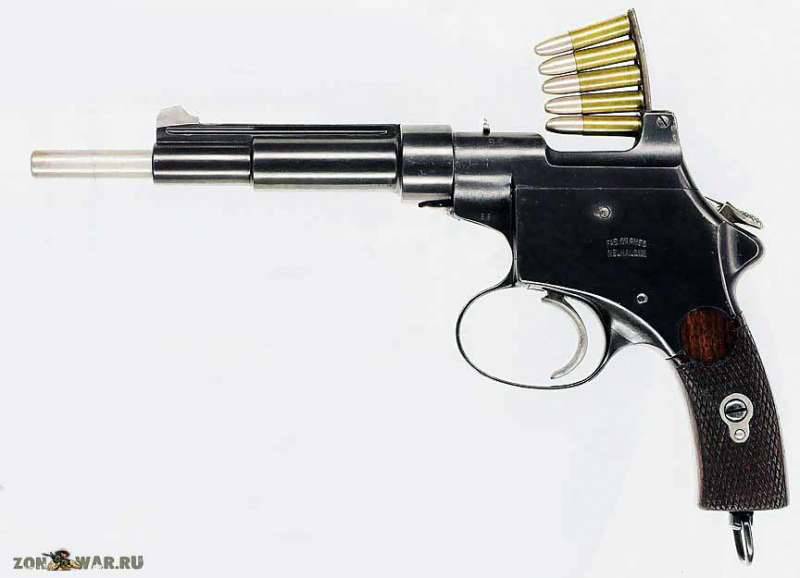
The process of loading. The barrel is pushed forward and locked by pressing the trigger. In the guide frame inserted clip with cartridges. Photo Zonwar.ru
So, loading with clips was considered too complicated. It was noted that the shooter could not reload the gun while in the saddle. In addition, M1894 lost to most revolvers in ready-to-use ammunition: five rounds against six. When used in double-action mode, trigger triggering did not differ from the mechanisms of revolvers. At the same time, the pistol was losing to double-action revolvers for the rate of fire. Finally, the rupture of the barrel in the 281-m shot spoke about the insufficient strength and reliability of the weapon.
The production of the Mannlicher M1894 pistols was launched in 1894 and lasted until 97. The weapons of the new design did not attract the special attention of the customers, because of which only a few batches of dozens of pistols each were made. Initially, only pistols for the 6,5-mm cartridge were made, and then a number of products were manufactured for 7,5x23 mm R ammunition. The total number of pistols made is estimated at 150-200 units.
After several tests in different countries, F. Manlicher failed to receive orders for the mass production of new weapons. For this reason, he made several attempts to update his design and enhance its characteristics. Later, various modifications of the firing mechanism, cartridge supply systems, etc. were used. In the frame it was proposed to place a two-row shop and make other changes. In addition, a single-action trigger pistol was proposed, requiring manual cocking before each shot. All these projects have not reached full implementation.
Due to the lack of real prospects, all manufactured pistols went to storage or, according to other data, were sold out. Because of their small number, they quickly left the turnover. After a few decades, it made them a real collectible value. At the moment it is known about the existence of only a few samples of the gun M1894, which managed to live to our times. They are of particular interest to collectors, and therefore have a corresponding price. For example, last fall, one of the 6,5-mm pistols went under the hammer for 14 thousand US dollars.
Despite the current status of especially valuable collection items, Mannlicher M1894 pistols were not highly appreciated by their contemporaries. The fact is that F. Mannicher, creating a new design, could not rely on proven and proven solutions and was forced to experiment. The result of this experiment was not very convenient, and also did not have high reliability.
The design of the M1894 pistol had some curious features, some of which can be considered positive. For example, it is necessary to note the simplicity of the design with a minimum of parts, as well as the elegant way of connecting store ammunition with the “revolving” trigger. Among other things, all this has reduced the size and weight of the weapon.
The use of automatics on the basis of a roll-out of the barrel made it possible to reduce the total recoil momentum, but the designer did not take advantage of this opportunity. F. Manlicher's pistol was supposed to fire with the barrel shifted back and the shutter closed. On other samples with similar automation, the barrel just before the shot had to move back from the extreme front position. At the same time, its displacement created a small impulse, which further extinguished some recoil from the shot. The Austro-Hungarian gunsmith did not use such a system, but later it was used in new projects and allowed to get some interesting results.
The lack of experience in creating self-loading pistols, characteristic of gunsmiths of the late XIX century, led to a number of technical and operational problems. It makes no sense to list them separately - the results of the American tests perfectly describe the situation and reveal the shortcomings of the M1894 project. In fact, the weapon turned out to be not very convenient and unreliable, and also did not have high performance and could not surpass the existing revolvers.
Ferdinand Manlicher self-loading pistol M1894 was one of the world's first representatives of its class. This weapon could fire without constant reloading manually: all operations with cartridges were made automatically. It should be noted that the pistol received a double-action revolving firing mechanism, but the main task of the project was solved by using new ideas and a completely new automation.
Unfortunately, as often happens with the first developments in a particular area, the M1894 pistol turned out to be more of an experimental model than a full-fledged military weapon. These or other characteristics of these weapons were insufficient, because of which it was inferior to revolvers. In addition, there was a problem in the form of low reliability. As a result, F. Manlicher’s first self-loading pistol did not reach full-scale serial production and operation in armies. However, he was able to take his place in stories small arms, and also became one of the most cherished desires of collectors.
On the materials of the sites:
http://weaponland.ru/
http://hungariae.com/
http://forgottenweapons.com/
http://zonwar.ru/
http://municion.org/
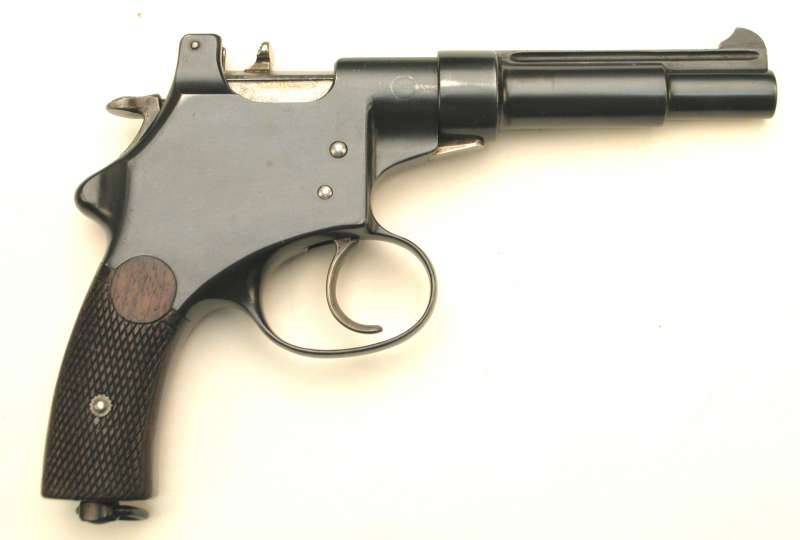
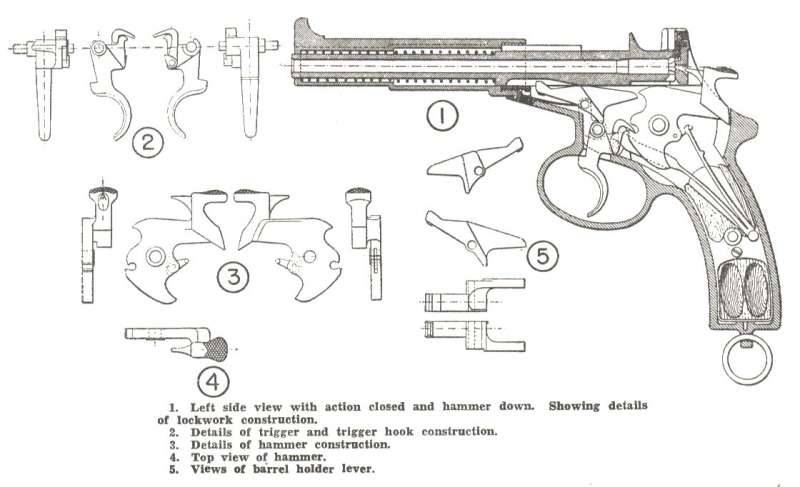
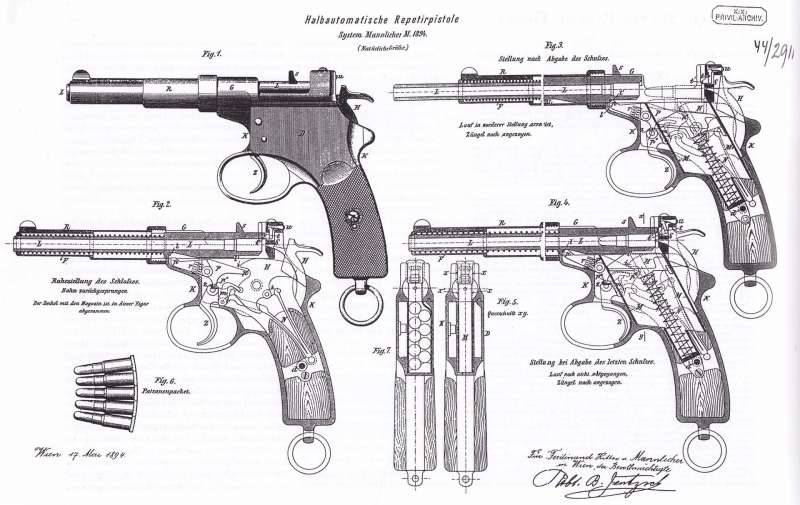
Information